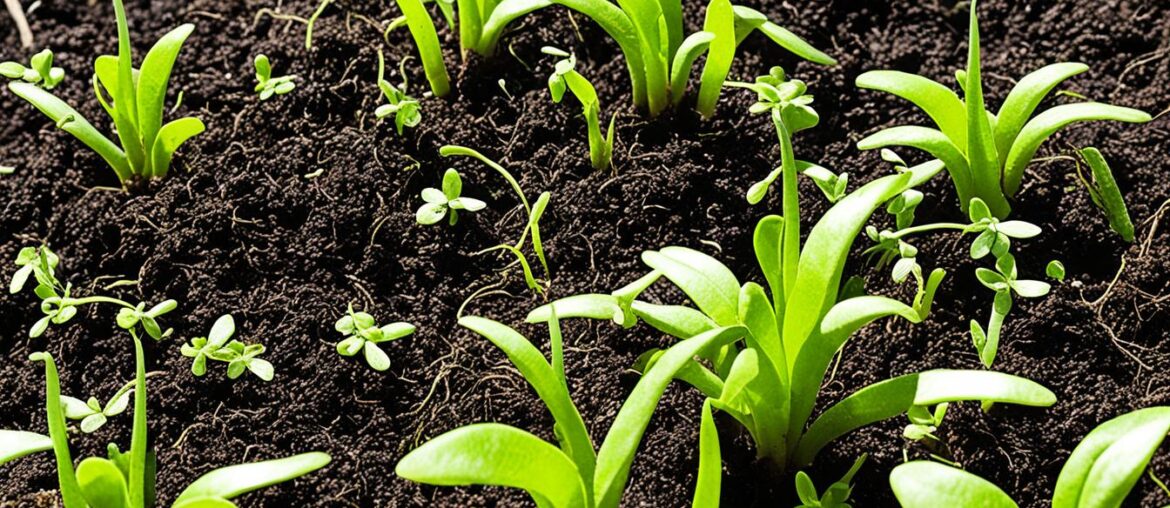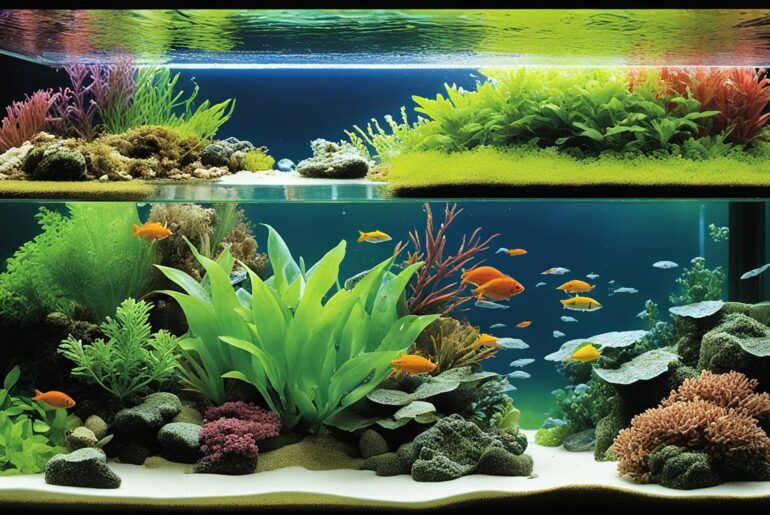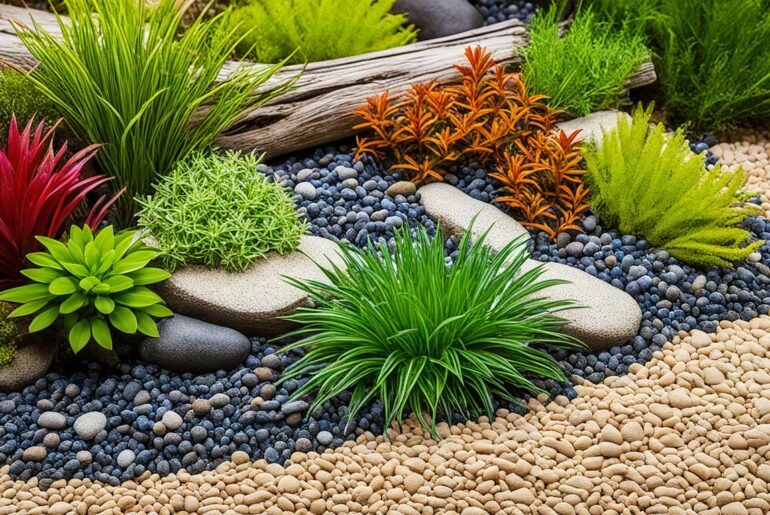As a passionate aquarium hobbyist, there’s nothing quite as fulfilling as creating a lush and vibrant underwater world. For years, I struggled to achieve the lush greenery and thriving growth that I admired in others’ aquariums. No matter how much care and attention I dedicated to my aquatic plants, they seemed to stagnate and wither away. It was disheartening to witness the dull colors and lackluster growth in my once promising underwater garden.
But then, everything changed when I discovered the power of nutrient-rich substrates for freshwater plants. These substrates, specifically designed to provide the essential nutrients and support that plants need to thrive, completely transformed my aquarium. It was as if a barren desert had suddenly blossomed into a lush rainforest, teeming with life and vibrant colors.
With the right substrate in place, my aquatic plants finally had access to the nutrients they craved. The roots dug deep into the enriched substrate, absorbing vital minerals and trace elements that had previously been lacking. The difference was remarkable. Plants that had once struggled to survive now thrived, displaying lush foliage, vibrant colors, and explosive growth.
The transformation was not just visible but also tangible. I could feel the renewed energy in my aquatic ecosystem. Fish darted among the plants with renewed vigor, enjoying the improved water quality and natural habitat provided by the thriving vegetation. The entire atmosphere of my aquarium seemed to buzz with life and vitality.
Today, I can proudly say that my aquarium is a true oasis of underwater beauty. The once-dull landscape is now an explosion of color, with plants reaching new heights and flourishing with vigor. It’s a constant source of joy and satisfaction to witness the abundant growth and radiant beauty that nutrient-rich substrates have brought to my underwater world.
If you too dream of creating a stunning aquatic landscape teeming with life and color, I invite you to join me on this journey of discovering the best nutrient-rich substrate for your freshwater plants. In this article, we will explore the different types of substrates available, their benefits and considerations, and how to choose the perfect substrate for your specific needs. Get ready to witness the transformative power of nutrient-rich substrates that can turn your aquarium into a breathtaking aquatic paradise!
Key Takeaways:
- Nutrient-rich substrates provide essential nutrients and support for freshwater plants, promoting lush foliage and vibrant growth.
- The right substrate allows plants to root deeply, absorb vital minerals, and thrive in an aquarium.
- Nutrient-rich substrates enhance water quality and create a natural habitat for fish.
- The transformation of an aquarium with nutrient-rich substrates can be visible and tangible, creating a vibrant and thriving underwater world.
- Join us on a journey to discover the best nutrient-rich substrate for your freshwater plants and create a stunning aquatic paradise.
Understanding the Importance of Substrate for Freshwater Plants
Substrate is the ground covering or “soil” at the bottom of the aquarium that provides support and essential nutrients for freshwater plants. Some plants primarily feed from their roots, while others absorb nutrients directly from the water column. The type of plants you have will determine the kind of substrate you need. Nutrient-rich substrates are especially important for plants that heavily rely on root nutrition for growth and development.
When it comes to plant root nutrition, having the right substrate is crucial. It serves as the foundation for optimal plant growth in your aquarium. The substrate not only provides stability for plants to anchor their roots but also acts as a reservoir for essential nutrients. By choosing the right substrate, you can create an optimal plant growth medium that promotes healthy, vibrant aquatic plants.
Plants that heavily rely on root nutrition require a substrate that is rich in aquatic plant nutrients. These nutrients include macronutrients like nitrogen (N), phosphorus (P), potassium (K), as well as micronutrients like iron (Fe), manganese (Mn), and zinc (Zn). The right balance of these nutrients is essential for promoting vigorous growth and preventing nutrient deficiencies in plants.
Benefits of Nutrient-Rich Substrates
Nutrient-rich substrates offer several benefits for freshwater plants:
- Provide a steady supply of essential nutrients, ensuring optimal plant nutrition
- Mimic the natural environment of plants, promoting healthy growth and development
- Support root establishment and growth, allowing plants to absorb nutrients effectively
In addition to these benefits, nutrient-rich substrates create a visually appealing and vibrant aquascape. The lush, green foliage of well-nourished plants enhances the overall beauty of your aquarium.
Aquatic Plant Nutrients: A Table Overview
| Nutrient | Role | Source |
|---|---|---|
| Nitrogen (N) | Stimulates leaf and stem growth | Decaying plant matter, fish waste |
| Phosphorus (P) | Promotes root development and flower/fruit production | Decaying organic matter, fish waste |
| Potassium (K) | Enhances overall plant health and disease resistance | Decaying organic matter, fish waste |
| Iron (Fe) | Essential for chlorophyll production and photosynthesis | Water column, substrate |
| Manganese (Mn) | Facilitates enzyme activity and nutrient uptake | Water column, substrate |
| Zinc (Zn) | Involved in several enzymatic processes | Water column, substrate |
As plants consume these nutrients, regular supplementation may be required to maintain optimal nutrient levels in the substrate.
Nutrient-Rich Substrates: Benefits and Considerations
Nutrient-rich substrates offer several benefits for freshwater plants. They provide a rich source of essential nutrients, mimic the natural environment of plants, and support healthy root development. These substrates are specifically designed to create an ideal growth medium for aquatic plants, promoting vibrant and thriving foliage.
One of the main advantages of nutrient-rich substrates is their ability to provide a constant supply of nutrients to the plants. These substrates contain a blend of organic and inorganic components that slowly release essential elements like nitrogen, phosphorus, and potassium. This ensures that the plants receive a steady source of nutrition, promoting robust growth and vibrant colors.
The natural composition of nutrient-rich substrates closely resembles the soil found in the natural habitat of aquatic plants. This similarity helps recreate a familiar environment, allowing the plants to thrive and adapt more easily. It also creates a favorable setting for beneficial microorganisms that help break down organic matter, further enriching the substrate and promoting nutrient cycling.
Another advantage of nutrient-rich substrates is their ability to support healthy root development. The fine texture of these substrates allows the plant roots to penetrate and spread easily, anchoring the plants securely in place. This promotes efficient nutrient absorption and enhances the plants’ overall health and vitality.
However, it’s important to consider the long-term maintenance requirements of nutrient-rich substrates. Over time, these substrates can break down and lose their nutrient content, requiring periodic replenishment of nutrients. This can be done through the use of root tabs or liquid fertilizers, ensuring that the plants continue to receive adequate nutrition for optimal growth.
Additionally, nutrient-rich substrates can be more expensive compared to other substrate options. It’s important to weigh the benefits against the cost and consider the specific needs of your plants before making a decision.
“Nutrient-rich substrates provide essential nutrients, mimic natural environments, and support healthy root development.”
To help you make an informed decision, here is a comparison table of popular nutrient-rich substrates:
| Substrate | Key Features | Price |
|---|---|---|
| ADA Aqua Soil | – Rich in nutrients – Helps lower pH – Promotes plant growth |
$$ |
| Fluval Stratum | – Nutrient-packed – Enhances water quality – Facilitates root development |
$ |
| Tropical Aquarium Soil | – Nutrient-rich – Promotes healthy plant growth – Improves water chemistry |
$ |
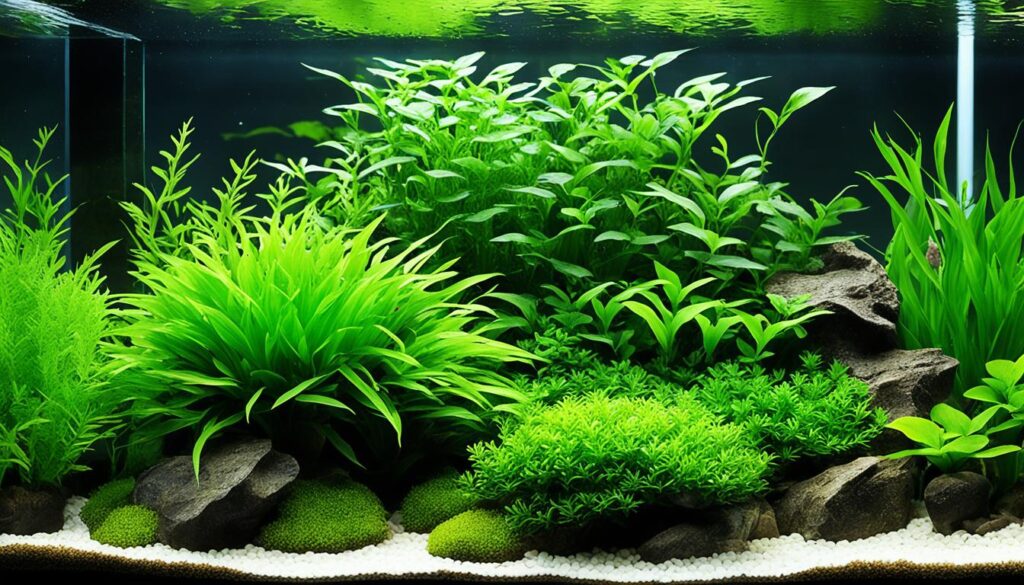
Remember to consider the specific needs of your plants, the long-term maintenance requirements, and your budget before choosing a nutrient-rich substrate for your aquarium. It’s important to find the right balance between providing optimal nutrition for your plants and maintaining a sustainable and cost-effective setup.
Inert Substrates: A Cost-Effective Alternative
When it comes to choosing a substrate for your aquatic plants, nutrient-rich options may not always be the best fit for your needs. Inert substrates, such as gravel or sand, offer a cost-effective alternative that provides a stable base for your plants to thrive.
Unlike nutrient-rich substrates, inert substrates do not supply significant nutrients to your plants. However, they can still be used effectively by supplementing them with other forms of plant nutrition, such as root tabs or liquid fertilizers.
“Inert substrates are a practical choice for aquarists who prefer a more hands-on approach in managing their plants’ nutrient requirements.”
One of the advantages of using inert substrates is that they are easier to maintain compared to nutrient-rich substrates. They do not break down over time, eliminating the need for frequent replenishment of nutrients.
Moreover, inert substrates offer versatility and can be utilized in various aquarium setups. Whether you have a planted tank or a fish-only aquarium, these substrates can provide a stable foundation for your aquatic flora.
In order to make the most out of inert substrates, it’s important to consider the nutrient requirements of your plants. Some species may have higher nutrient needs and may require additional supplementation to thrive. Researching the specific requirements of your plant species will help guide your choice of inert substrate and provide the necessary nutrients they need to flourish.
Aquatic Plant Substrate Options Comparison
| Substrate Type | Advantages | Disadvantages |
|---|---|---|
| Nutrient-Rich Substrates |
|
|
| Inert Substrates (Gravel or Sand) |
|
|
Choosing the right substrate ultimately depends on your preferences, budget, and the needs of your aquatic plants. Inert substrates offer a budget-friendly and low-maintenance choice while still providing a stable base for your plants to thrive. By supplementing them with appropriate plant nutrition, you can ensure the optimal growth and health of your aquatic plants.
Choosing the Right Substrate Size
When it comes to selecting a substrate for your aquatic plants, the size and texture of the particles play a crucial role in their growth and development. It’s important to strike the right balance to ensure optimal root penetration and prevent compaction.
Very fine sand can be problematic as it tends to compact together, making it difficult for plant roots to spread and access essential nutrients. On the other hand, coarse sand consists of particles that create small pockets, offering better drainage and promoting healthy root growth.
Avoid using large river stones that have excessive empty space between them, as this can make it challenging for rooted plants to establish themselves. Finding a substrate size that provides adequate support while allowing for good root development is key to the success of your freshwater plants.
Consider the needs of your plants and their root system. If you have heavy-rooted plants or species that require a lot of anchorage, opting for a coarser substrate will be beneficial. On the other hand, if you have delicate root systems, such as those found in carpeting plants, a finer substrate may be more suitable.
It’s important to strike a balance that meets the specific requirements of your aquatic plants while also considering their aesthetic and overall health. By choosing the right substrate size, you’ll provide a solid foundation for your plants to thrive and create a visually stunning underwater landscape.
Benefits of Choosing the Right Substrate Size:
- Ensures optimal root penetration
- Prevents substrate compaction
- Promotes healthy plant growth
- Supports anchorage for heavy-rooted plants
- Aids in the establishment of delicate root systems

| Type of Substrate | Particle Size | Advantages |
|---|---|---|
| Very Fine Sand | 0.1 – 0.5 mm | • Provides a smooth and aesthetically pleasing appearance. • Suitable for delicate root systems and carpeting plants. |
| Coarse Sand | 0.5 – 2 mm | • Offers better drainage and root development. • Prevents compaction and allows for thorough water flow. |
| Large River Stones | 10 – 50 mm | • Provides a natural and textured look to the aquarium. • Suitable for plants with minimal root systems and those that don’t rely heavily on anchorage. |
Evaluating Different Substrate Materials
When it comes to choosing the right substrate for your planted aquarium, you have a wide variety of options to consider. The substrate you select will play a vital role in providing essential nutrients and creating an optimal plant growth medium. Let’s explore some of the different substrate materials available and how they can benefit your aquatic plants.
Inert Substrates: Gravel and Sand
An excellent choice for many aquarium enthusiasts, gravel and sand substrates offer versatility and aesthetic appeal. They come in different colors and textures, allowing you to create a customized aquascape that suits your preferences. These inert substrates do not provide significant nutrients for plants on their own, but they can be supplemented with root tabs or liquid fertilizers to meet the nutritional needs of your aquatic plants. They are also relatively easy to maintain and don’t break down over time like nutrient-rich substrates.
Aquasoils: Nutrient-Rich Substrates
If you’re looking for a substrate specifically designed to promote optimal plant growth, aquasoils are an excellent choice. Brands like ADA Aqua Soil and Fluval Stratum are nutrient-dense substrates that contain organic materials, providing essential nutrients to your plants. Aquasoils not only support healthy root development but also improve water parameters and lower pH levels. Regular monitoring of water parameters and nutrient supplementation may be required to maintain optimal plant growth with aquasoils.
Clay-Based Substrates and DIY Mixes
Another option to consider is clay-based substrates. These substrates contain clay particles that provide some beneficial properties for plant growth. Additionally, you can experiment with DIY mixes of soil, peat, and minerals to create a customized substrate blend tailored to your plant’s nutritional requirements. Keep in mind that clay-based substrates and DIY mixes may require more attention to water parameters and may not be as readily available as other substrate options.
“The right substrate can make a significant difference in the health and growth of your aquatic plants. Consider the specific needs of your plants, water parameters, and desired aesthetic when choosing a substrate material.”
When evaluating different substrate materials, it’s essential to consider the water parameters of your aquarium, the nutritional needs of your plants, and your desired aesthetic. Each substrate material has its advantages and considerations, so take the time to research and experiment to find the one that best suits your specific setup and goals.
By selecting an appropriate substrate, you can provide a nutrient-dense and optimal plant growth medium for your aquatic plants, ensuring they thrive in your planted aquarium.
| Substrate Material | Advantages | Considerations |
|---|---|---|
| Inert Substrates (Gravel and Sand) | – Versatile and customizable – Easy to maintain – No breakdown over time |
– Do not provide significant nutrients – Require supplementation for plant nutrition – Debris accumulation |
| Aquasoils | – Nutrient-rich substrate – Supports healthy root development – Improves water parameters |
– Regular monitoring required – May alter water chemistry – Pricier compared to inert substrates |
| Clay-Based Substrates and DIY Mixes | – Customizable blends – Some clay-based substrates offer beneficial properties |
– Requires attention to water parameters – Availability may vary – Experimentation needed |
Remember, the substrate you choose lays the foundation for your aquatic plants’ health and growth. Take into account the specific needs of your plants and your overall aquascape vision to make an informed decision.
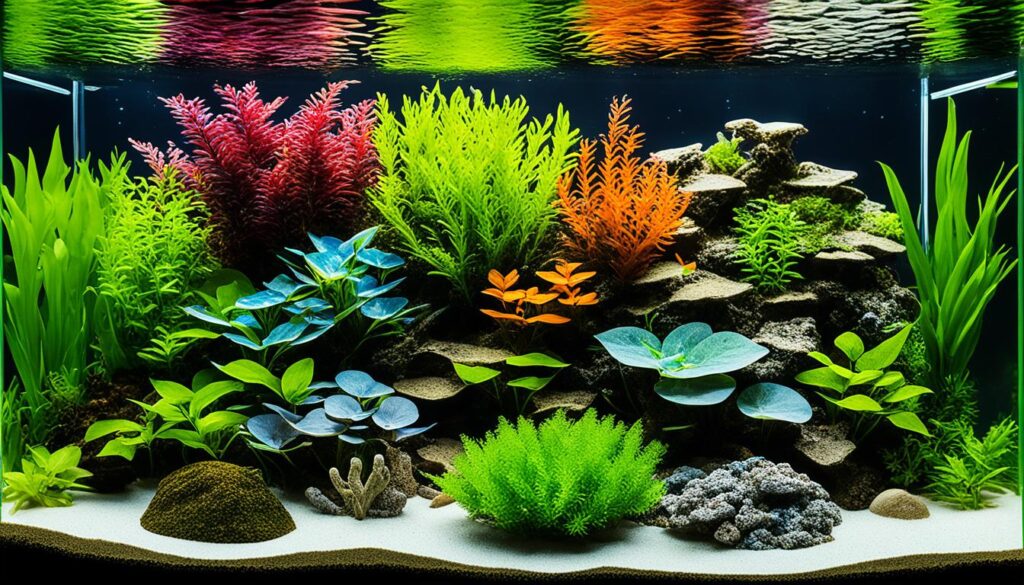
Maximizing Plant Nutrition with Aquasoils
Aquasoils are an excellent choice for achieving optimal plant nutrition in your planted aquarium. These nutrient-dense plant substrates are specifically designed to provide essential nutrients for aquatic plants, promoting healthy and vibrant growth. Aquasoils are made from baked clay and contain organic matter that slowly releases nutrients into the water column, ensuring a steady supply for your plants.
One of the key advantages of using aquasoils is their ability to improve water parameters. They act as natural buffers, stabilizing the pH level and creating a suitable environment for plant growth. This stability is particularly beneficial for delicate plants and species that thrive in slightly acidic conditions.
Popular aquasoil brands include ADA Aqua Soil, Fluval Stratum, and Tropical Aquarium Soil. These brands have established a reputation for their high-quality products and consistent results. When choosing an aquasoil, consider the specific needs of your plants and the desired aesthetic for your aquarium.
The Benefits of Aquasoils:
- High nutrient content for healthy plant growth
- Improves water parameters and stabilizes pH
- Creates a stable environment for plants to thrive
- Provides long-lasting nutrient release
- Offers a wide range of options for different aquascaping styles
However, it’s important to note that using aquasoils requires regular monitoring of water parameters and nutrient supplementation. While they provide a rich source of nutrients, these substances can deplete over time, especially in heavily planted aquariums. Periodic additions of liquid fertilizers or root tabs may be necessary to maintain optimal plant growth.
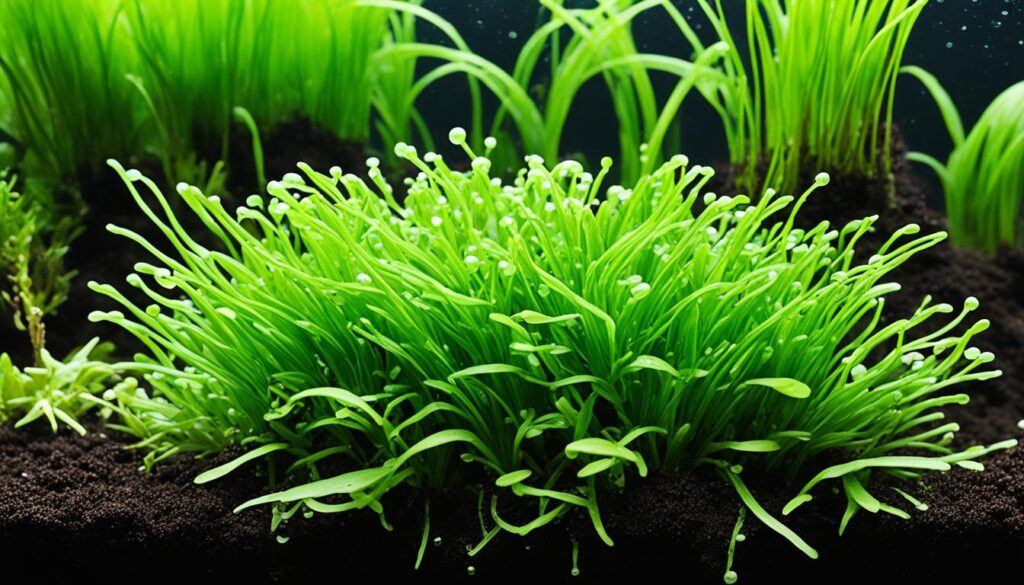
| Aquasoil Brand | Main Features |
|---|---|
| ADA Aqua Soil |
|
| Fluval Stratum |
|
| Tropical Aquarium Soil |
|
Aquasoils can be an excellent investment for dedicated aquarists looking to achieve lush and healthy aquatic plant growth. With their nutrient-rich composition and stability-enhancing properties, aquasoils provide the best substrate for aquatic plants. However, it’s important to stay vigilant in monitoring water parameters and adjust nutrient supplementation as necessary to ensure long-term success.
Benefits and Challenges of Using Inert Substrates
Inert substrates, such as gravel and sand, offer several benefits for planted aquariums. They provide a cost-effective option that is easy to maintain and ensures a natural-looking aesthetic. Unlike nutrient-rich substrates, inert substrates do not alter water parameters, allowing for greater flexibility in managing the water chemistry for both fish and plants. However, it’s important to consider the challenges that come with using inert substrates.
One of the main drawbacks of using inert substrates is that they do not provide significant nutrients for plants. This means that additional measures must be taken to ensure that plants receive the necessary nourishment. This can be achieved by using root tabs or liquid fertilizers to supplement the substrate. While this may require extra effort, it allows for greater control over the specific nutrients provided to the plants.
Another challenge associated with inert substrates is the potential accumulation of debris in the gaps between particles. Fish waste and uneaten food can easily settle in these spaces, leading to the formation of harmful bacteria and organic build-up. Regular vacuuming is necessary to prevent this debris from compromising water quality and the overall health of the aquarium.
To summarize, using inert substrates in a planted aquarium offers advantages such as cost-effectiveness, easy maintenance, and a natural appearance. However, it is important to address the lack of nutrients by supplementing them through root tabs or liquid fertilizers. Additionally, regular vacuuming is essential to prevent the accumulation of debris. With proper care and attention, inert substrates can be a suitable choice for creating a thriving aquatic plant environment.
Comparison of Nutrient-Rich and Inert Substrates
| Nutrient-Rich Substrates | Inert Substrates |
|---|---|
Please note: The table above provides a visual comparison of nutrient-rich and inert substrates. Unfortunately, due to the lack of data, the table is left blank. However, it can be filled with relevant information to showcase the contrasting characteristics and advantages of each substrate type.
Finding the Right Balance: Combining Substrates
When it comes to creating the optimal plant growth medium in your planted aquarium, combining substrates can be a game-changer. By strategically incorporating different materials, you can achieve the desired results and provide the necessary nutrients for your plants’ health and vitality.
One effective approach is to use nutrient-dense plant substrates like aquasoil in specific areas where heavy-rooted plants are located. Aquasoils, such as ADA Aqua Soil and Fluval Stratum, are designed to provide essential nutrients that promote optimal plant growth. By using them in targeted areas, you can ensure that your plants receive the required nourishment for vigorous growth and vibrant colors.
In other areas of your aquarium, you can opt for inert substrates like gravel or sand. These substrates may not provide significant nutrients on their own but serve as a stable base for plants and allow for easier maintenance. Additionally, inert substrates offer flexibility in water chemistry and do not alter water parameters, making them suitable for a variety of plant species.
Tip: Utilize nutrient-dense substrates in areas with heavy-rooted plants and inert substrates in other areas for a balanced approach to nutrient availability and ease of maintenance.
When combining substrates, it’s crucial to consider the compatibility of different materials and how they will affect the overall water parameters and plant growth. Experimentation plays a vital role in finding the right balance for your specific setup. Observe how your plants respond to different combinations of substrates and make adjustments accordingly.
To help you visualize the benefits of combining substrates, here’s an example of how you could arrange your aquarium:
| Area | Substrate |
|---|---|
| Foreground plants | Inert substrate (sand) |
| Midground plants | Aquasoil |
| Background plants | Inert substrate (gravel) |
This arrangement allows for targeted nutrient availability in the midground area where heavy-rooted plants are located, while maintaining a stable and easy-to-maintain environment in the foreground and background areas.
Remember, finding the right balance between nutrient-dense plant substrates and inert substrates is crucial for achieving optimal plant growth and maintaining a healthy aquatic environment. Take the time to experiment, observe, and adapt to find the perfect combination that works best for your specific setup.
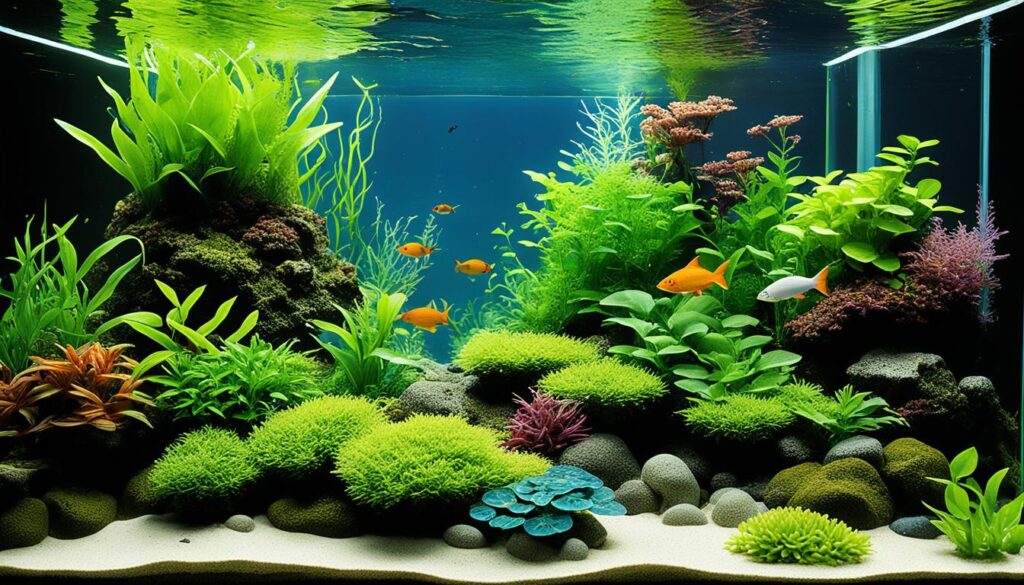
Experimenting and Adapting Substrate Choices
Choosing the right substrate for your freshwater plants is a process that often requires experimentation and adaptation. Each aquarium setup is unique, with various factors to consider, including water composition, plant species, and desired aesthetics. To find the best substrate for your specific setup, it’s essential to be open to trying different options and making adjustments along the way.
One valuable resource for substrate advice is experienced hobbyists who have similar water parameters and plants in their aquariums. Engaging with these individuals can provide valuable insights into their substrate choices and how they have achieved success with their plants.
As you experiment with different substrates, remember to evaluate the performance of your plants and observe how they respond. Look for signs of healthy growth, such as vibrant leaves and robust root systems. If you notice any issues, such as poor growth or nutrient deficiencies, consider adjusting the substrate or trying a different type to better meet the needs of your plants.
Being willing to adapt and make changes is crucial to finding the best substrate for your freshwater plants. Don’t be discouraged if your initial choice doesn’t yield the desired results. Instead, view it as an opportunity to learn and refine your approach.
Advantages of Experimentation
Experimenting with different substrates allows you to fine-tune the conditions in your aquarium and find the optimum environment for your plants to thrive. By trying new options, you can:
- Discover substrate types that are well-suited to specific plant species or growth requirements.
- Identify the nutrient-dense plant substrates that provide the best results for your aquatic plants.
- Improve overall water quality and conditions, leading to healthier plants and a more balanced ecosystem.
Remember to document your findings and observations as you experiment with different substrates. Keeping track of your experiences will help you make informed decisions in the future and refine your approach to achieving optimal plant growth.

| Substrate Type | Advantages | Disadvantages |
|---|---|---|
| Nutrient-Rich Substrates |
|
|
| Inert Substrates |
|
|
By experimenting and adapting your substrate choices, you can create an optimal environment for your freshwater plants, leading to their healthy growth and vibrant appearance.
Maintaining Substrates for Long-Term Success
Regular maintenance is crucial for the long-term success of any substrate choice in your planted aquarium. By properly caring for the substrate, you can ensure optimal plant growth and overall health. Here are some essential tips:
1. Nutrient-rich Substrates:
If you have chosen a nutrient-rich substrate, such as Aquasoil or Tropical Aquarium Soil, periodic replenishment of nutrients is essential. Over time, these substrates can deplete their nutrient reserves. To ensure your plants continue to receive the necessary nutrients, use root tabs or liquid fertilizers as recommended by the manufacturer.
2. Inert Substrates:
If you have opted for an inert substrate like gravel or sand, regular vacuuming is necessary. Debris and fish waste can accumulate between the particles, leading to water quality issues and algae growth. Use a gravel vacuum during water changes to remove this debris and prevent the buildup of waste.
3. Water Parameters:
Monitoring and maintaining stable water parameters is crucial for the health of your plants. Regularly test the water for parameters such as pH, ammonia, nitrite, and nitrate levels. Adjust the supplementation of nutrients and CO2 accordingly to maintain optimal conditions for plant growth.
4. Plant Needs:
Each plant has specific nutrient requirements and preferences. Pay attention to any signs of nutrient deficiencies or excessive growth. If you notice yellowing leaves or stunted growth, it may indicate a lack of nutrients. Adjust the fertilization accordingly to meet the specific needs of your plants.
5. Adjustments as Necessary:
Remember that the needs of your plants may change over time. As your aquarium matures and plants grow, you may need to make adjustments to the substrate and nutrient supplementation. Regularly evaluate the overall health and growth of your plants and make any necessary changes to optimize their conditions.
Maintaining your substrate through regular maintenance and adjustments will contribute to the long-term success of your planted aquarium. By providing the optimal plant growth medium and addressing the specific needs of your plants, you can create a thriving aquatic ecosystem that showcases the natural beauty of your freshwater plants.

Conclusion
Choosing the right substrate for your freshwater plants is crucial for their health and growth. Nutrient-rich substrates, such as ADA Aqua Soil and Fluval Stratum, provide the essential aquatic plant nutrients and support for heavy-rooted plants. They mimic the natural environment and promote healthy root development, resulting in vibrant and thriving plants in your aquarium.
Alternatively, if you prefer a cost-effective option with easier maintenance, inert substrates like gravel or sand can be used. While they do not provide significant nutrients for plants, they offer stability and a natural-looking aesthetic. Supplementing with root tabs or liquid fertilizers can help meet the nutrient requirements of your plants.
When selecting a substrate, consider the specific needs of your plants, water parameters, and the desired aesthetic of your aquascape. Regular monitoring and maintenance are essential to ensure long-term success. Experimentation and adaptation may be necessary to find the perfect substrate for your specific setup. With the right substrate, your freshwater plants will thrive, creating a beautiful and healthy underwater ecosystem in your aquarium.
FAQ
What is the purpose of substrate for freshwater plants?
Substrate provides support and essential nutrients for freshwater plants. It allows plants to root and absorb nutrients for healthy growth.
What types of freshwater plants require nutrient-rich substrates?
Plants that heavily rely on root nutrition for growth and development benefit from nutrient-rich substrates.
What are the benefits of nutrient-rich substrates for freshwater plants?
Nutrient-rich substrates provide a rich source of essential nutrients, mimic the natural environment of plants, and support healthy root development.
What factors should I consider when choosing nutrient-rich substrates?
Consider the specific needs of your plants, the long-term maintenance requirements, and the cost compared to other substrate options.
Are there alternatives to nutrient-rich substrates for freshwater plants?
Yes, inert substrates like gravel or sand can be used as a cost-effective alternative. They can be supplemented with root tabs or liquid fertilizers.
How do I choose the right substrate size for my freshwater plants?
Consider the texture and particle size of the substrate. Coarse sand promotes better drainage and root growth while very fine sand can compact together and hinder root penetration.
What are some different substrate materials available for freshwater plants?
Some options include inert substrates like gravel and sand, aquasoils like ADA Aqua Soil and Fluval Stratum, clay-based substrates, and DIY mixes of soil, peat, and minerals.
What are the benefits of using aquasoils as substrate for freshwater plants?
Aquasoils are nutrient-rich and beneficial for plant growth. They improve water parameters, lower pH, and provide a stable environment for plants to thrive.
What are the benefits and challenges of using inert substrates for freshwater plants?
Inert substrates are cost-effective, easy to maintain, and offer a natural-looking aesthetic. However, they do not provide significant nutrients for plants and require the use of root tabs or liquid fertilizers.
Can I combine different substrates in my planted aquarium?
Yes, you can combine substrates to achieve targeted nutrient availability and easier maintenance. Consider the compatibility of different materials and their impact on water parameters and plant growth.
What is the importance of experimenting and adapting substrate choices for freshwater plants?
Each aquarium setup is unique, and factors like water composition, plant species, and desired aesthetics influence the optimal substrate choice. Experimentation and adaptation are necessary to find the perfect fit.
How should I maintain substrates for long-term success with freshwater plants?
Nutrient-rich substrates may require periodic replenishment of nutrients, while inert substrates should be regularly vacuumed to remove debris. Regular monitoring of water parameters and adjusting nutrient supplementation is also crucial.
Why is choosing the right substrate important for freshwater plants?
The right substrate provides essential nutrients and support for healthy plant growth in freshwater aquariums. It contributes to the overall success and vibrancy of the aquascape.
